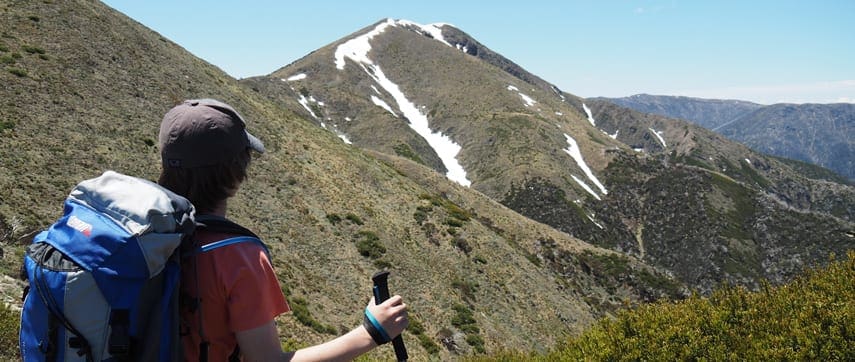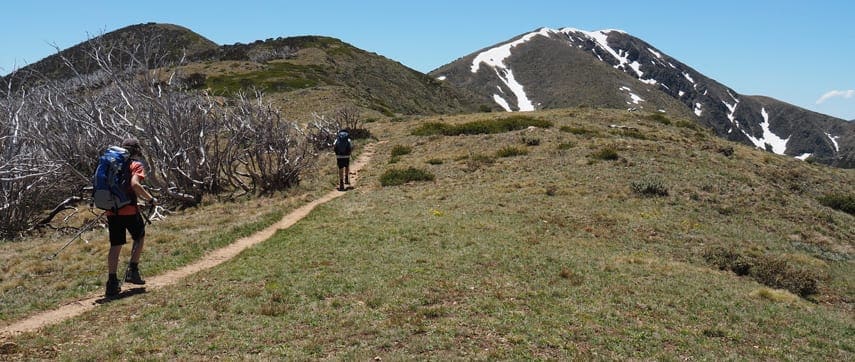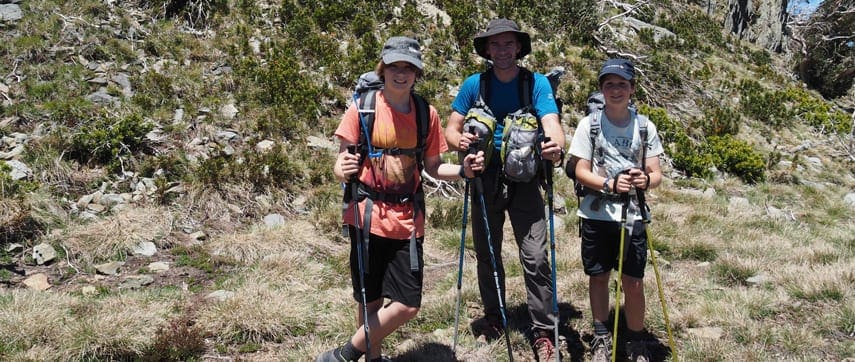Do your kids hear the call of the great outdoors? I used to hike a lot without my kids as I was fearful that they would not be ready or enjoy the experience. To me that would have been devastating as I really wanted them to enjoy hiking as much as me. Whether you have toddlers, young children or pre-teens, it is, with some planning and preparation, possible to answer the call with kids in tow.
Smart Planning
1. Start Small
When overnight hiking with kids it is really important that you scale your adventure to suit your kids and to start them small. You may be into peak-bagging and challenging alpine hikes and can’t wait to introduce your kids to the wonders of the high country wilderness, but make yourself start small and build as they are not going to be able to handle as much as you are.
2. Distance
Kids wearing packs do much better hiking over distance than they do with elevations. A few flat kilometres are much easier than half a kilometre of switchbacks or steep ascents. Plan your daily distance based on age. The rule of thumb I use is that kids can easily cover 1 kilometer of trail for every year of their age. So an eight year old should easily be able to hike 8-10km in a day. It is a rule of thumb and you will know your child’s stamina better than anyone, just don’t let them fool you.
3. Terrain
I always try to ensure that the terrain is varied with rocks, logs and uneven surfaces. there is nothing more boring for kids than walking along a well graded path and you will hear them asking ‘how much further’ about five minutes into the hike.
4. Set the pace
Slowing down the pace on the trail to keep the kids engaged with animal tracks, plant identification, photo-taking, frequent snacks, exploring rocks and caves etc. can pay huge dividends. This will keep them interested and stop them from feeling like they are hiking for hours on end.
5. Know when to quit
It helps to be flexible and know when to quit; if you’re on day three of living in a tent in the rain, there’s no shame in retreating to a motel. The last thing you want to do is stick it out and make it a horrible experience.

Be Prepared
If you often hike overnight then you should already know and understand what you need to pack for the environment and terrain. If you are new to overnight hikes yourself there is probably no way you can think of everything you need to take. The following are some key items that I suggest you consider “must-haves” for successful family hiking trips:
- Individual water bottles or hydration packs … and more water than you think you need
- Snacks: Jerky, pepperoni, Babybel cheese, fruit snacks, squeezable applesauce, trail mix, snakes, jelly beans
- If appropriate, diaper disposal/management (Zip-Loc bags)
- Individual torch and/or headlamps. Enough so that everyone has one as kids will love to have their own
- Glowsticks for nighttime fun (and a nightlight for bedtime)
- Trowel for digging in the dirt or sand at the campsite and for toileting
- Marshmallows for the campfire, if conditions and the destination allow
- Extra socks and underwear
- An extra sleeping bag in case of accidents in the night or other disasters
- Sunscreen and lightweight long-sleeve shirts, regardless of season. Sun hats, too.
- Insect repellent; you also might want to consider just suing clothes & hats. They’re easier and not greasy like liquid repellent.
- Easy-to-transport games and cards, as well as books and sketchbooks is weight allows
- Duct tape, because everyone should carry this
- Red wine for after the kids go to bed
Invest in the Right Equipment
A rule of thumb for hiking is that very active kids can carry up to 20% of their body weight, less active kids should carry less. A 6-year-old should be able to handle a pack, a kid-sized sleeping bag, their water and some light clothing, but total weight should not top 5 kilograms.
The Pack
As for the backpack itself, make sure you’re buying something with a frame. Both internal and external frames are great, but frame-less (school packs) aren’t going to work at all on the trail. Make sure the torso harness is adjustable. It’s not enough to have adjustable straps on the shoulder pads; the entire torso length should be modifiable, usually via a slider. Kids grow quickly, so check and adjust the torso length every time you head out on your next overnight hike.
In general, kids ages 5-10 can get away with a 25 to 40 litre pack. Pre-teens and teens can move into the 40 to 50 litre range. Depending on your childs size, and how much you think they’ll grow as a teen, you’ll need to choose whether to upgrade to something made for teenagers, or just jump to an adult’s small-sized pack once they outgrow their starter gear. For all of our overnight hikes my boys use my 40 litre packs and that is more than large enough to carry their water, clothes, sleeping bag and pad.
Sleeping bags
When it comes to sleeping bags, your child’s really cool cartoon-character sleeping bag is heavy and bulky and, on top of it all, not very warm. Look for kids sleeping bags with temperature ratings appropriate for the worst-case weather. It’s much better to have a 0-degree bag and not need it than a freezing your child in a +12-degree bag. The space that the sleeping bag will take up ion their pack will be dictated by how much you spend. It might just be that you have to carry their sleeping back in your pack. I generally take three +5 sleeping bags. They are small and fit in the palm of my hand and my boys can throw one over the top of themselves to keep them a bit warmer. Thermals are also an excellent idea in order to keep them warmer at night.
Sleeping Pad
An inflatable sleeping pad adds another 500 grams, but makes for a much more comfortable night. Most pads are available in a “short” size that’s ideal for younger campers but I figure you may as well buy an adult size as they will continue to grow.
Tent
There are hundreds of light weight hiking tents available on the market. You should not expect children under 12 to carry their own tent so whatever you buy, make sure you can easily carry it in your pack. At least until they get older and stronger.
Be Careful
Wherever you decide to hike and camp remember, hazards exist.
- Bodies of water, in particular, need to be treated with the respect they deserve, and kids around them (particularly when it’s moving water) need to be watched at all times.
- Burns from campfires are a common injury among kids in the outdoors. Keep in mind that often the burns happen not around blazing fires, but when kids are playing around seemingly dead fires the next morning and encounter hot coals under the ashes.
- Out on the trail, I always equip my kids with whistles, a torch and knife. Instruct them that these items are for emergencies only and that they should not blow the whistle just for fun. I have seen kids on the trail who will drive you nuts blowing on them all day. Whistles are a warning and signal device and should not be used as toys or without reason
- Teach your kids to stick with a buddy, and to “hug a tree” and stay put if they should discover that they’re alone and don’t know where they are.
- And finally, of course, travel with a fully stocked first aid kit, and maybe even a snake bite kit.
When it comes to your kids you can never be over-prepared; as you gain experience you’ll naturally figure out the difference between what is necessary and what’s overkill.
Think of Your Kids
I have been overnight hiking with my kids —now ages 11 and 13 (in 2017)—since they were very young. It is a wonderful experience which really helps you to connect as a family and with nature. I have a small amount of advice on overnight hiking with kids through all ages, and on being purposeful in your hiking experiences:
“I think the goal for me getting my kids out into the wilderness early was to foster a love of the outdoors. This was a gift that my parents gave me growing up, one that I wanted to pass along. When you are dealing with little ones ages 0-6, it’s important to keep everything fun and simple. The goal is to keep them interested and willing to go with you year after year. Little ones don’t really have bragging rights yet and just want to be safe and having fun. Non-camping activities can be helpful, such as crafts, books, and games.”
“Primary-school kids want to have fun and will benefit a lot from hiking with their peers. So bring their friends along. I always felt it was easier hiking in group settings at this age with other kids as they ,motivate each other and spur each other on. With peer pressure added in, mine were always more helpful around the camp, interested in what we were cooking, and willing to hike farther and stay up later. ‘Junior Ranger’ programs are popular for this age group. Using the outdoors as a learning tool is great, and even having ‘homework’ for them to do based on where you’re going and what you’re seeing can create a more lasting memory and richer experience.”
“Hiking with teenagers is more about supervision, and also about you letting go. Friends are key, and allowing them to plan meals, cook, and eventually drive can give them ownership of the trip. The goal here would be to train them to be able to get out on their own as young adults. This is the age when you can start purchasing them their own gear that they’ll use for years to come, or helping them choose what will work for them.”
Lastly, have fun and cherish the amazing memories and strong connections that you will create together.
Author: Darren Edwards – Trail Hiking Australia












